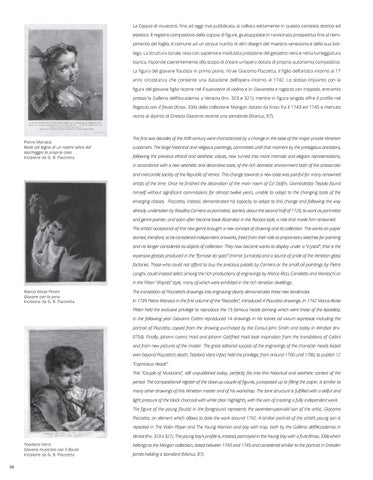La Coppia di musicanti, fino ad oggi mai pubblicata, si colloca esttamente in questo contesto storico ed estetico. Il registro compositivo della coppia di figure, giustapposte in ravvicinata prospettiva fino al riempimento del foglio, è comune ad un corpus nutrito di altri disegni del maestro veneziano e della sua bottega. La struttura tonale, resa con sapiente e modulata pressione del gessetto nero e netta lumeggiatura bianca, risponde coerentemente allo scopo di creare un’opera dotata di propria autonomia compositiva. La figura del giovane flautista in primo piano, ritrae Giacomo Piazzetta, il figlio dell’artista intorno ai 17 anni; circostanza che consente una datazione dell’opera intorno al 1742. Lo stesso impianto con la figura del giovane figlio ricorre nel Il suonatore di violino e in Giovanetta e ragazzo con trappola, entrambi presso la Galleria dell’Accademia a Venezia (Inv. 323 e 321), mentre in figura singola offre il profilo nel Ragazzo con il flauto (Knox, 33A) della collezione Mongan datato da Knox fra il 1743 ed 1745 e ritenuto vicino al dipinto di Dresda Giacomo recante uno stendardo (Mariuz, 87).
Pietro Monaco Raab col segno di un nastro salva dal saccheggio la propria casa Incisione da G. B. Piazzetta
The first two decades of the XVIII century were characterized by a change in the taste of the major private Venetian customers. The large historical and religious paintings, committed until that moment by the prestigious ancestors, following the previous ethical and aesthetic values, now turned into more intimate and elegant representations, in accordance with a new aesthetic and decorative taste, of the rich domestic environment both of the aristocratic and mercantile society of the Republic of Venice. This change towards a new taste was painful for many renowned artists of the time. Once he finished the decoration of the main room of Ca’ Dolfin, Giambattista Tiepolo found himself without significant commissions for almost twelve years, unable to adapt to the changing taste of the emerging classes. Piazzetta, instead, demonstrated his capacity to adapt to this change and following the way already undertaken by Rosalba Carriera as portraitist, started, about the second half of 1720, to work as portraitist and genre painter, and soon after became book illustrator in the Rococo style, a role that made him renowned. The artists’ acceptance of this new genre brought a new concept of drawing and its collection. The works on paper started, therefore, to be considered independent artworks, freed from their role as preparatory sketches for painting and no longer considered as objects of collection. They now became works to display under a “crystal”, that is the expensive glasses produced in the “fornase da speci” (mirror furnaces) and a source of pride of the Venetian glass factories. Those who could not afford to buy the precious pastels by Carriera or the small oil paintings by Pietro Longhi, could instead select among the rich productions of engravings by Marco Ricci, Canaletto and Marieschi or in the Pitteri “d’après” style, many of which were exhibited in the rich Venetian dwellings.
Marco Alvise Pitteri Giovane con la pera Incisione da G. B. Piazzetta
The translation of Piazzetta’s drawings into engraving clearly demonstrates these new tendencies. In 1739 Pietro Monaco in the first volume of the “Raccolta”, introduced 4 Piazzetta drawings. In 1742 Marco Alvise Pitteri held the exclusive privilege to reproduce the 15 famous heads (among which were those of the Apostles); in the following year Giovanni Cattini reproduced 14 drawings in his Icones ad vivium expressae including the portrait of Piazzetta, copied from the drawing purchased by the Consul John Smith and today in Windsor (Inv. 0754). Finally, Johann Lorenz Haid and Johann Gottfried Haid took inspiration from the translations of Cattini and from new pictures of the master. The great editorial success of the engravings of the character heads lasted even beyond Piazzetta’s death; Teodoro Viero infact held the privilege, from around 1760 until 1780, to publish 12 “Capricious Heads”. This "Couple of Musicians", still unpublished today, perfectly fits into this historical and aesthetic context of the period. The compositional register of the close-up couple of figures, juxtaposed up to filling the paper, is similar to many other drawings of this Venetian master and of his workshop. The tone structure is fulfilled with a skilful and light pressure of the black charcoal with white clear highlights, with the aim of creating a fully independent work. The figure of the young flautist in the foreground represents the seventeen-year-old son of the artist, Giacomo Piazzetta, an element which allows to date the work around 1742. A similar portrait of the artist’s young son is repeated in The Violin Player and The Young Woman and boy with trap, both by the Galleria dell’Accademia in Venice (Inv. 323 e 321). The young boy’s profile is, instead, portrayed in the Young boy with a flute (Knox, 33A) which
Teodoro Viero Giovane musicista con il flauto Incisione da G. B. Piazzetta 66
belongs to the Morgan collection, dated between 1743 and 1745 and considered similar to the portrait in Dresden James holding a standard (Mariuz, 87).
